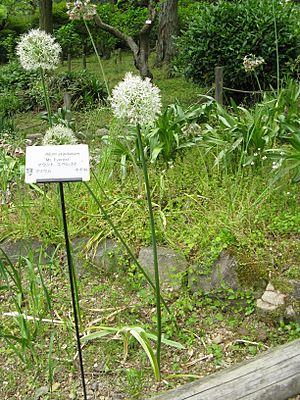Allium stipitatum facts for kids
Quick facts for kids Allium stipitatum |
|
|---|---|
 |
|
| ‘Mount Everest’ | |
| Scientific classification | |
| Genus: |
Allium
|
| Species: |
stipitatum
|
| Synonyms | |
|
|
The Persian shallot, also known as Allium stipitatum, is a type of onion plant. It grows naturally in parts of central and southwestern Asia.
Some scientists think that Allium stipitatum and another plant called A. hirtifolium are the same. This plant is found in many countries, including Turkey, Iraq, Iran, Pakistan, Afghanistan, and several countries in Central Asia like Uzbekistan and Kazakhstan.
The name stipitatum means 'with a little stalk'. This refers to how the plant's ovary is shaped.
Contents
What Does the Persian Shallot Look Like?
Allium stipitatum grows from round bulbs, which are like underground storage organs. These bulbs are about 3 to 6 centimeters (1 to 2.5 inches) wide. They have a blackish, papery outer skin.
- The plant usually has 4 to 6 wide leaves at its base.
- These leaves are green to grayish-green and can be a bit hairy.
- By the time the plant flowers, its leaves usually dry up and wither away.
The flowers grow on tall stems, which can be 60 to 150 centimeters (about 2 to 5 feet) tall. The flowers are grouped together in a special shape called an umbel. This looks like many small flowers all growing from one central point, like the spokes of an umbrella.
- The umbels are about 8 to 12 centimeters (3 to 5 inches) wide.
- They might seem small compared to the very tall stems. This is why these plants are sometimes called 'drumstick alliums'.
- Each small flower has a typical onion-like shape.
- They have six petal-like parts, called tepals, which are usually lilac to purple. Some white forms of the flowers are also known.
These plants often grow on rocky hillsides and in fields. They are found at high places, between 1,500 and 2,500 meters (about 4,900 to 8,200 feet) above sea level. Because it looks like a 'drumstick allium' with a round flower head on a tall stem, it can sometimes be confused with other similar plants.
How Persian Shallots Are Used in Cooking
The bulbs of Allium stipitatum are eaten in Iran. There, they are called موسیر (pronounced /muːˈsiːɾ/). These shallots grow wild in the Zagros Mountains.
Most of the shallots eaten in Iran are gathered from the wild. They are often:
- Sliced thinly.
- Dried.
- Sold in local markets.
Before eating, people often soak the dried shallots for several days. Then, they boil them to make the flavor milder. A very popular way to eat them is to crush them and mix them with yogurt. Many Iranians enjoy this yogurt dish, especially in restaurants that serve kebabs.
Growing Persian Shallots for Gardens
Many people find Allium stipitatum to be a very impressive plant for gardens. It is considered one of the easiest tall alliums to grow. If you plant its seeds, it can take about four years for the plant to flower.
To grow these plants well in your garden, it's best to choose:
- A sunny spot.
- Soil that drains water easily.
It's good to think carefully about where to plant 'drumstick alliums'. This is because their leaves can look a bit messy and withered when the plant is flowering. On the bright side, these plants often produce many small new bulbs, called offsets. This means they can spread easily in a garden border.
Two special types of Allium stipitatum are very popular for gardens:
- ‘Mount Everest’
- ‘Violet Beauty’
Both of these have won the Royal Horticultural Society’s Award of Garden Merit. This award means they are excellent plants for gardening.
See Also
Images for kids




